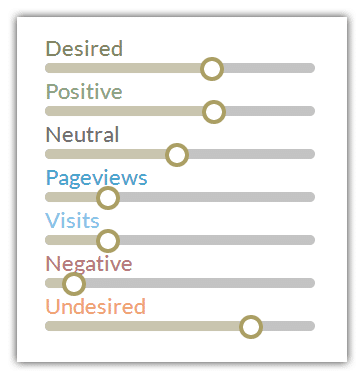WYSDOM Success Metric
 The importance of storytelling in marketing communications is not only reflected in the interactive visualizations of the webLyzard dashboard, but also in its success metrics. Positive versus negative sentiment affects the popularity of a brand, company, or topic. The webLyzard Stakeholder Dialog and Opinion Model (WYSDOM) provides a dynamic assessment of this popularity. Thereby, it allows real-time insights into the success of marketing and public outreach activities.
The importance of storytelling in marketing communications is not only reflected in the interactive visualizations of the webLyzard dashboard, but also in its success metrics. Positive versus negative sentiment affects the popularity of a brand, company, or topic. The webLyzard Stakeholder Dialog and Opinion Model (WYSDOM) provides a dynamic assessment of this popularity. Thereby, it allows real-time insights into the success of marketing and public outreach activities.
Measures of attention and sentiment are descriptive in nature. The hybrid WYSDOM success metric, by contrast, reveals whether you have reached your communication targets. It measures to what extent your strategy has an impact on observable patterns in online coverage. The success metric also reflects how consistently a message is being conveyed, and whether this message helps to reinforce brand positioning.
Impact Assessment and Communication Success Metric
WYSDOM evaluates the degree of association between an organization (or its products and services) with desired topics considered important and in line with evolving marketing goals. It also determines whether you have successfully avoided undesired topics and media coverage. This goes far beyond simple Share of Voice-based success scores. As a success indicator, it is also superior to lexical metrics such as sentiment or more fine-grained classifications of human emotions. In the case of a climate research center, for example, a desired association with “climate change” contributes positively to the success metric, although the term typically carries a negative sentiment.
 The WYSDOM success metric represents an adaptive measure. It is part of an iterative feedback cycle. With each cycle, you can customize the metric to your evolving communication and dissemination goals. To specify these goals, you have full control over a lists of desired and undesired semantic associations. Moreover, there is alway the opportunity to update these associations according to your changing priorities. It is possible to store the desired and undesired associations as part of a bookmark definition. The Brand Reputation Radar is a visual tool that guides and supports this customization process.
The WYSDOM success metric represents an adaptive measure. It is part of an iterative feedback cycle. With each cycle, you can customize the metric to your evolving communication and dissemination goals. To specify these goals, you have full control over a lists of desired and undesired semantic associations. Moreover, there is alway the opportunity to update these associations according to your changing priorities. It is possible to store the desired and undesired associations as part of a bookmark definition. The Brand Reputation Radar is a visual tool that guides and supports this customization process.
Key Performance Indicators (KPIs)
Optionally, WYSDOM provides seamless integration of Web site analytics. For this purpose, the system captures server access statistics such as visits, page views and average viewing time. The data originate from existing log file analysis tools such as Google Analytics or Piwik. The integrated approach allows communication professionals to analyze successful strategies in terms of both their impact on content production (e.g. news articles, social media coverage) and on content consumption (e.g. measure of customer activity on a corporate Web site). You can use the same functionality to render other Key Performance Indicators (KPIs) that reflect marketing success. This can include the number of customers, for example, the churn rate or loyalty metrics such as the Net Promoter Score (NPS). When tracking social perceptions of products, aggregated sales figures such as Monthly Recurring Revenue (MRR) are additional candidate variables.
Visual Representation of the Success Metric
The screenshot below shows an interactive representation of the WYSDOM success metric based on a stacked bar chart. Green areas above the horizontal axis represent the association with (i) desired topics and the number of (ii) positive references. The red and orange areas below the axis, by contrast, show the number of (iii) negative references and the association with (iv) undesired topics. Grey areas indicate the number of (v) neutral references. At the same time, blue areas let you track the number of (vi) visits and (vii) page views. To sum it all up, the dark grey line depicts the overall WYSDOM score.
On hover, a tooltip displays additional context information, for example topics and opinion leaders responsible for observable changes. Using a slider element, you can assign weights to the above mentioned seven components to specify the importance for your current task.

The Next Generation of Content-Based Success Metrics
The WYSDOM Success Metric played a pivotal role in the ReTV Project on Enhancing and Re-Purposing TV Content. ReTV was a Horizon 2020 Innovation Action funded by the European Commission. The project aimed for a seamless integration of communication success metrics and prediction models. Both have been built into an iterative content repurposing workflow. For this purpose, webLyzard extracts metrics from secondary content channels such as Web pages, social media postings or accompanying content like snippets. We then associate these metrics with specific TV media assets.
The project extended existing success metric by: (i) moving from bipolar sentiment to multiple-dimensional emotional categories such as anticipation, surprise and joy, (ii) providing measures beyond awareness, for example a customer’s intent to purchase, and (iii) replacing daily intervals by a shorter timespan granular enough to track the impact of short-term interventions – for example, changes in a company’s advertising strategy.
Selected Publications
- Weichselbraun, A., Steixner, J., Braşoveanu, A.M.P., Scharl, A., Göbel, M. and Nixon, L.J.B. (2022). Automatic Expansion of Domain-Specific Affective Models for Web Intelligence Applications, Cognitive Computation, 14(1): 228-245.
- Scharl, A., Herring, D., Rafelsberger, W., Hubmann-Haidvogel, A., Kamolov, R., Fischl, D., Föls, M. and Weichselbraun, A. (2017). Semantic Systems and Visual Tools to Support Environmental Communication, IEEE Systems Journal, 11(2): 762-771.
- Scharl, A. and Herring, D. (2013). Extracting Knowledge from the Web and Social Media for Progress Monitoring in Public Outreach and Science Communication. 19th Brazilian Symposium on Multimedia and the Web (WebMedia-2013). Salvador da Bahia, Brazil: ACM. 121-124.


 Source: CDC
Source: CDC